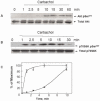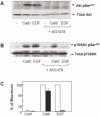Carbachol induces p70S6K1 activation through an ERK-dependent but Akt-independent pathway in human colonic epithelial cells
- PMID: 19615971
- PMCID: PMC2754135
- DOI: 10.1016/j.bbrc.2009.07.060
Carbachol induces p70S6K1 activation through an ERK-dependent but Akt-independent pathway in human colonic epithelial cells
Abstract
Stimulation of human colonic epithelial T84 cells with the muscarinic receptor agonist carbachol, a stable analog of acetylcholine, induced Akt, p70S6K1 and ERK activation. Treatment of T84 cells with the selective inhibitor of EGF receptor (EGFR) tyrosine kinase AG1478 abrogated Akt phosphorylation on Ser(473) induced by either carbachol or EGF, indicating that carbachol-induced Akt activation is mediated through EGFR transactivation. Surprisingly, AG1478 did not suppress p70S6K1 phosphorylation on Thr(389) in response to carbachol, indicating the G protein-coupled receptor (GPCR) stimulation induces p70S6K1 activation, at least in part, via an Akt-independent pathway. In contrast, treatment with the selective MEK inhibitor U0126 (but not with the inactive analog U0124) inhibited carbachol-induced p70S6K1 activation, indicating that the MEK/ERK/RSK pathway plays a critical role in p70S6K1 activation in GPCR-stimulated T84 cells. These findings imply that GPCR activation induces p70S6K1 via ERK rather than through the canonical PI 3-kinase/Akt/TSC/mTORC1 pathway in T84 colon carcinoma cells.
Figures



Similar articles
-
Carbachol stimulates transactivation of epidermal growth factor receptor and mitogen-activated protein kinase in T84 cells. Implications for carbachol-stimulated chloride secretion.J Biol Chem. 1998 Oct 16;273(42):27111-7. doi: 10.1074/jbc.273.42.27111. J Biol Chem. 1998. PMID: 9765228
-
EGF receptor transactivation mediates ANG II-stimulated mitogenesis in intestinal epithelial cells through the PI3-kinase/Akt/mTOR/p70S6K1 signaling pathway.Am J Physiol Gastrointest Liver Physiol. 2005 Feb;288(2):G182-94. doi: 10.1152/ajpgi.00200.2004. Epub 2004 Sep 9. Am J Physiol Gastrointest Liver Physiol. 2005. PMID: 15358595
-
Transactivation of the epidermal growth factor receptor mediates muscarinic stimulation of focal adhesion kinase in intestinal epithelial cells.J Cell Physiol. 2005 Apr;203(1):103-10. doi: 10.1002/jcp.20190. J Cell Physiol. 2005. PMID: 15389641
-
Distinct pathways of ERK activation by the muscarinic agonists pilocarpine and carbachol in a human salivary cell line.Am J Physiol Cell Physiol. 2008 Jun;294(6):C1454-64. doi: 10.1152/ajpcell.00151.2007. Epub 2008 Apr 2. Am J Physiol Cell Physiol. 2008. PMID: 18385290
-
Differential FAK phosphorylation at Ser-910, Ser-843 and Tyr-397 induced by angiotensin II, LPA and EGF in intestinal epithelial cells.Cell Signal. 2007 May;19(5):1000-10. doi: 10.1016/j.cellsig.2006.11.004. Epub 2006 Nov 22. Cell Signal. 2007. PMID: 17240116 Free PMC article.
Cited by
-
Vitamin E succinate induces apoptosis via the PI3K/AKT signaling pathways in EC109 esophageal cancer cells.Mol Med Rep. 2016 Aug;14(2):1531-7. doi: 10.3892/mmr.2016.5445. Epub 2016 Jun 27. Mol Med Rep. 2016. PMID: 27357907 Free PMC article.
-
Airway and lung remodelling in chronic pulmonary obstructive disease: a role for muscarinic receptor antagonists?Drugs. 2015 Jan;75(1):1-8. doi: 10.1007/s40265-014-0319-0. Drugs. 2015. PMID: 25414120 Review.
-
PKD1 mediates negative feedback of PI3K/Akt activation in response to G protein-coupled receptors.PLoS One. 2013 Sep 9;8(9):e73149. doi: 10.1371/journal.pone.0073149. eCollection 2013. PLoS One. 2013. PMID: 24039875 Free PMC article.
-
Epidermal growth factor receptor transactivation is required for mitogen-activated protein kinase activation by muscarinic acetylcholine receptors in HaCaT keratinocytes.Int J Mol Sci. 2014 Nov 21;15(11):21433-54. doi: 10.3390/ijms151121433. Int J Mol Sci. 2014. PMID: 25421240 Free PMC article.
-
Calmodulin enhances mTORC1 signaling by preventing TSC2-Rheb binding.J Biol Chem. 2025 Feb;301(2):108122. doi: 10.1016/j.jbc.2024.108122. Epub 2024 Dec 22. J Biol Chem. 2025. PMID: 39716490 Free PMC article.
References
-
- Rozengurt E. Early signals in the mitogenic response. Science. 1986;234:161–166. - PubMed
-
- Rozengurt E. Neuropeptides as growth factors for normal and cancer cells. Trends Endocrinol Metabol. 2002;13:128–134. - PubMed
-
- Rozengurt E, Walsh JH. Gastrin, CCK, signaling, and cancer. Annu. Rev. Physiol. 2001;63:49–76. - PubMed
-
- Rozengurt E. Mitogenic signaling pathways induced by G protein-coupled receptors. J Cell Physiol. 2007;213:589–602. - PubMed
-
- Rozengurt E. Growth factors and cell proliferation. Curr. Opin. Cell Biol. 1992;4:161–165. - PubMed
Publication types
MeSH terms
Substances
Grants and funding
LinkOut - more resources
Full Text Sources
Molecular Biology Databases
Research Materials
Miscellaneous

